 “He’ll eat almost anything, idea wise, or he’ll at least chew on it. What he swallows is another matter. That’s partly because the psychedelic springs from a common-sense filled, well-informed, experience-tempered and morally solid soul.”
“He’ll eat almost anything, idea wise, or he’ll at least chew on it. What he swallows is another matter. That’s partly because the psychedelic springs from a common-sense filled, well-informed, experience-tempered and morally solid soul.”
That’s how Rolling Stone described Robert Downy Jr. in a recent article.
A “mental omnivore.”
Great phrase.
It means all devouring.
It means eating ideas indiscriminately.
It means taking in everything available.
It means approaching life experiences with deep democracy.
THAT’S THE SECRET: If you walk through life as a mentally omnivorous person, you will triple your interestingness, forever inspire your creativity and build a bottomless reservoir of diverse ideas to fuel your daily endeavors.
Dee-licious.
Here’s how to become one:1. Constantly cast about for content. During a recent webinar, one of my callers asked the one question that absolutely drives me crazy: “Scott, where do you get your ideas?”
Are you kidding me? Have you not walked down the street before? Ideas are more abundant than oxygen.
The problem is, most people don’t pay attention. They don’t listen with their hearts. They don’t see with their mouths. And they don’t hear with their fingers.
That’s what mental omnivores practice: Incurable curiosity. You don’t have writer’s block – you have hearing damage. Perk up, son. When was the last time you ran out of ideas?
2. Adopt a role of humble inquiry. As a mental omnivore, here’s your credo: Sapere aude. That’s the Latin phrase for “dare to know,” first used in Horace’s first book of Epistles.
According to The Latin Library, the phrase forms the moral to a story where a fool waits for the stream to stop before crossing it. “He who begins is half done,” Horace says.
This speaks to the value of human endeavor, which, if you’re a mental omnivore, is absolutely essential. You’ve got to get your ass out of the basement and into the world.
That’s how you acquire an experiential dimension: By falling awake, armed only with your pen, an open mind and a furrowed brow.
Lesson learned: Keep why alive. Insulated from inquiry means inundated with injury. Why do you need permission to ask why?
3. Never turn a deaf ear to nature. Marcus Aurelius once remarked, “Healthy eyes see whatever is visible.” To put that principle into practice, try this: Pursue the intuitive pull of the moment, follow the lead of the subject and penetrate the mosaic of every environment.
Plunge yourself insatiably into whatever stimuli surround you, giving your most careful attendance to the ordinary things that don’t matter to most people.
Try this, and it won’t be crowded at the viewing center. Which means the perceptual landscape will be yours – and yours alone – to navigate.
That’s the cool part about being a mental omnivore: You notice things nobody else seems to pick up on, thinking to yourself, “Am I the only person who sees this?” Odds are, yes. Well done.
Remember: He who watches for opportunity sees a show everywhere. What do you need to stop ignoring?
4. React to simple things differently. With a beagle-like tilted head, start asking why things are the way they are; why things do the things they do; and why people say the things they say. And if possible, ask more than once.
Here’s why: When you slow down to find out what’s behind the silence, you’ll be amazed how effortless it is to take your ideas into deeper structures.
And that’s when the real learning begins: When you perfect your ability to notice a simple fragment – but recognize the entire whole.
The tricky part is: You have to show up for all of it. Even the mundane. You have to occupy the beginner’s mind to turn the world into a wide-open field.
Otherwise you’ll take the gold for granted. Are you willing to see the poetry in the exceptionally ordinary?
5. Everything is fair game. Here’s the approach I take to creativity: I never met a piece of content I didn’t like. And the limitless sources of ideas are as richly dense as a Shanghai street party.
My suggestion is: To cement your insights and give cohesion to the chaos, fuse information from every source you can get. Embroider the accumulated threads of daily observation into a striking tapestry of innovative thinking.
With this kind of palette diversity, it becomes easier to discover new dimensions of awareness and locate more layers of insight. As long as you commit to being bolder in your experimentation.
Otherwise your ideas will be about as exciting as Creed’s Behind the Music. Are you actively approaching the world with posture of deep democracy?
6. Be meticulous in your attendance to language. The most fascinating book I read this year was The Notebooks of F. Scott Fitzgerald.
From cultural observations to personal stories to linear notes to transient thoughts, he documented everything. Everything. And through his constant observation and meticulous attendance to language, Fitzgerald became one of the classic mental omnivores of his generation.
Your mission is to emulate his process: Document stray phrases, cool words, unexpected juxtapositions, overheard-at-the-office-comments and other random dialogues.
Keep a record of your reactions to issues. Create a separate folder for each one. Update, revisit and revise them daily. Your creative reservoir is guaranteed never to run dry. When people speak, what do you hear?
7. Relentlessly seek out new innovations. Force yourself to look more broadly. Even if the innovative ideas come from industries and arenas outside of your normal scope. Especially if the innovative ideas come from industries and arenas outside of your normal scope.
That’s how you acquire intellectual versatility. That’s how you keep your mind at full stretch. By keeping your eyes fastened attentively and objectively upon all indications of innovation.
I’ve had career-changing epiphanies that spawned from unexpected, unrelated and unorthodox sources. How far down the rabbit hole are you willing to go?
AND NOW, FOR DESSERT: As we wrap up our discussion on being a mental omnivore, let’s turn to an excerpt from the 2009 commencement speech at Sonoma State University commencement, delivered by the always omnivorous, Henry Rollins:
“Your curiosity must never wane! Ever. You are, therefore you want to know, want to go, want to know more and want to go further. As college graduates, you know all too well how much there is to know and the incalculable amount of fascinating things there are to explore, from thought to geographic destination.
It is your curiosity that you must enhance, strengthen and value, more and more as the years go on and on. It is your curiosity that you must guard against exhaustion, apathy and that awful plague called middle age.
Yes, you are allowed occasional but brief vacations from your curiosity: Box sets of television shows and carbohydrate rich foods are permitted – but don’t make a career out of it.
It is your curiosity that you will pass on like a genetic trait to your children, infect all those around you like a virus and inspire the anger of those who have chosen to admit defeat.
Because one of the greatest and most powerful words in any language is: Why.
When you stop wanting to find out, you’re done. There are few things more unendurable than being forced to spend time with someone who is intellectually incurious.
This can never be you. Ask a question. Go forth. Arrive at the answer. Catch your breath. Ask Why. And then set off again. Never relent.”
LESSON LEARNED: Go eat something.
It doesn’t have to be good.
It doesn’t have to be good for you.
It doesn’t have to be your favorite item on the menu.
But eat it anyway.
Your colleagues will thank you.
Your customers will thank you.
Your brain will thank you.
Dee-licious.
LET ME ASK YA THIS…
Are you a mental omnivore?
LET ME SUGGEST THIS…
For the list called, “13 Things Losers Do,” send an email to me, and you win the list for free!
* * * *
Scott Ginsberg
That Guy with the Nametag
Author, Speaker, Entrepreneur, Mentor
[email protected]
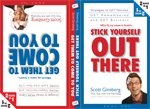 The world’s FIRST two-in-one, flip-flop book!
The world’s FIRST two-in-one, flip-flop book!
Buy Scott’s comprehensive marketing guidebook on Amazon.com and learn how to GET noticed, GET remembered and GET business!

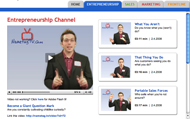
 “They don’t care if you’re good – they care if people come.”
“They don’t care if you’re good – they care if people come.”
 Although I started wearing a nametag in 2000, it wasn’t until 2005 that I officially got the nametag tattooed on my chest.
Although I started wearing a nametag in 2000, it wasn’t until 2005 that I officially got the nametag tattooed on my chest. 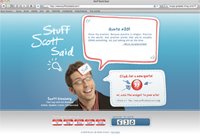 Who’s quoting YOU?
Who’s quoting YOU? “What scares you?”
“What scares you?”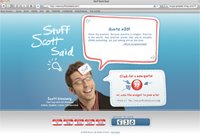 Who’s quoting YOU?
Who’s quoting YOU? “What scares you?”
“What scares you?”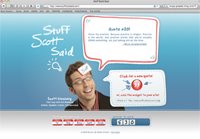 Who’s quoting YOU?
Who’s quoting YOU? The Seven Dwarfs never had to deal with a recession.
The Seven Dwarfs never had to deal with a recession.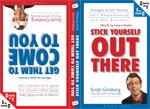 The world’s FIRST two-in-one, flip-flop book!
The world’s FIRST two-in-one, flip-flop book! “Is it your place to fix this?”
“Is it your place to fix this?” Who’s quoting YOU?
Who’s quoting YOU? You can’t beat self-employment.
You can’t beat self-employment.